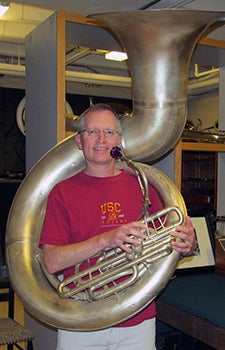A Sousa-phony Exposed
Vacationing with his family at the Interlochen Center for the Arts in Interlochen, Michigan, three years ago, alumnus Dave Detwiler remembered that the music school held in its possession the first sousaphone ever made — or, at least, it claimed to.
A lifelong musician and accomplished tuba player in his youth, Detwiler, who graduated with a bachelor’s in social sciences and communications in 1984, was compelled to learn more.
“Talking to the curator, what piqued my interest was that he wasn’t even sure it was the first sousaphone,” Detwiler recalled. “But nobody was saying otherwise, so they kept saying it was.”
Following curiosity
On sabbatical from his job as a pastor for what then was the BranchCreek Community Church in Harleysville, Pennsylvania, (it has since been renamed the Lives Changed by Christ Church), Detwiler embarked on a curiosity-driven research project that would eventually uncover the truth about the original sousaphone — and also unearth some details about the politics of America’s leading musicians and instrument makers at the turn of the 20th century.
Conceived by John Philip Sousa, who at the time was director of the United States Marine Band, the sousaphone is a type of tuba that originally sent sound upward and over the band. Devised for a concert setting, the instrument has proved popular among marching bands because of the way it wraps around the body and rests on the player’s left shoulder.

Detwiler holds what was thought to be the first-ever sousaphone at Michigan’s Interlochen Center for the Arts in 2012. He has since proved that another instrument preceded it. Photo courtesy of Dave Detwiler.
“I have a lot of connections with tuba players, and I know a few music historians,” Detwiler explained, “and what I stumbled upon during these conversations was the possibility that the first sousaphone was made by a company called J.W. Pepper, which happens to be headquartered in Philadelphia.”
He visited the company and learned that the instrument still existed, but was at that time housed at the Museum of Making Music in Carlsbad, California — not Interlochen, Michigan. That instrument had been constructed by C.G. Conn, a bitter rival of Pepper.
Solving the mystery
But the question remained: Which sousaphone came first?
“I started tracking it down. I got a lead here and a lead there,” Detwiler said. “I ended up at the U.S. Marine Band Library in Washington, D.C., which has significant archives, and eventually found a collector in Kentucky who was able to give me absolute, irrefutable proof that the horn made by J.W. Pepper was in fact the original.”
Don Johnson had a Pepper Journal from 1895 that referenced a letter from Herman Conrad, the first sousaphone player in history. The letter, written on Oct. 14 of that year, mentioned the sousaphone built by Pepper — two or three years before Conn’s instrument even existed.
Even more direct evidence came from an article featured in the Aug. 30, 1922, edition of the Christian Science Monitor in which Sousa is quoted:
“The sousaphone received its name through a suggestion made by me to J. W. Pepper, the instrument manufacturer of Philadelphia, fully 30 odd years ago… I spoke to Mr. Pepper relative to constructing a bass instrument in which the bell would turn upwards and be adjustable for concert purposes. He built one and, grateful to me for the suggestion, called it the sousaphone.”
More to the story
So why didn’t Sousa toot his horn on behalf of Pepper between 1893 and 1922?
“I don’t know exactly what kind of politics went on back then, but we do know that Conn and Sousa were very close,” Detwiler said. “Conn gave Sousa a number of free instruments for his band, and in return Sousa promoted Conn. They were kind of scratching each other’s backs.
“I have a feeling Sousa didn’t make much mention of the Pepper horn until 1922 because he was kind of hanging with Conn during those years — and we also know that Pepper and Conn hated each other. They were intense rivals in the industry, so there is enough there to suggest that Sousa had reason to keep hush-hush about the original instrument.”
Since completing his research, Detwiler has published a paper in the International Tuba Euphonium Association (ITEA) Journal and had a front-page feature on it in The Philadelphia Inquirer.
A member of the Trojan Marching Band when he was at USC, Detwiler picked up the tuba again when his son started playing in elementary school. He is now an active member of the Montgomery County Concert Band.
Although he has largely returned to life as a teaching pastor, father, husband and amateur musician, Detwiler is proud that he followed his intuition — knowing there was a story behind Interlochen’s claim — until he had an answer.
“It was all just for kicks; I was doing it for fun,” he said. “But my whole life is devoted to leading people to truth, and I’m thrilled to have helped clarify the truth about this often-maligned member of the tuba family.”